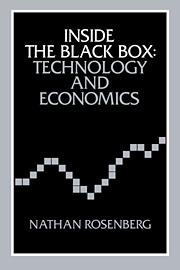Book contents
- Frontmatter
- Contents
- Preface
- Part I Views of technical progress
- Part II Some significant characteristics of technologies
- Part III Market determinants of technological innovation
- 8 Technical change in the commercial aircraft industry, 1925–1975
- 9 The economic implications of the VLSI revolution
- 10 The influence of market demand upon innovation: a critical review of some recent empirical studies
- Part IV Technology transfer and leadership: the international context
- Index
9 - The economic implications of the VLSI revolution
Published online by Cambridge University Press: 08 January 2010
- Frontmatter
- Contents
- Preface
- Part I Views of technical progress
- Part II Some significant characteristics of technologies
- Part III Market determinants of technological innovation
- 8 Technical change in the commercial aircraft industry, 1925–1975
- 9 The economic implications of the VLSI revolution
- 10 The influence of market demand upon innovation: a critical review of some recent empirical studies
- Part IV Technology transfer and leadership: the international context
- Index
Summary
To examine the prospective economic impact of a development in electronics–VLSI (very large scale integration)–we must first focus explicitly upon the variables which mediate between the technological and the economic realms, that is, between technical feasibility and commercial success.
Cost versus performance
Within the purely technological realm one can deal with performance criteria, or with the solution of mechanical or other engineering problems, in a relatively unconstrained way. So long as cost considerations are not critical, one can conceive of a wide range of technically feasible alternatives for improving the speed of an airplane, increasing the strength of a bridge or the hardness of a material, or providing an electricity supply for a specific location. However, technical success (or purely mechanical performance measures) is only a necessary and not a sufficient condition in establishing social usefulness. The bankruptcy courts provide evidence of the perils of an excessive preoccupation with technical feasibility or performance, and it is notorious that the over-whelming bulk of patents are never commercialised.
For a technological improvement to exercise a significant social impact, it must ordinarily fulfill additional criteria. Specifically, it must combine design characteristics that will match closely with the needs and tastes of ultimate users, and it must accomplish these things subject to the basic economic constraint of minimising costs. The major exceptions, in our society, are defence and related aero-space expenditures, where enormous priority is placed upon performance and where cost considerations are regarded as secondary.
- Type
- Chapter
- Information
- Inside the Black BoxTechnology and Economics, pp. 178 - 192Publisher: Cambridge University PressPrint publication year: 1983



